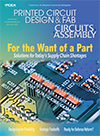Case studies show cleaning the workplace can harm materials and equipment.
During the pandemic, cleaning and disinfecting common areas and surfaces to protect and remove the Covid-19 virus and all other viruses and bacteria has become urgent. During this time manufacturers have turned to professional cleaning services or have assigned facilities departments the responsibility of properly disinfecting areas. Adding corrosive chemicals to the working environment is a new condition. While the CDC issued guidelines for human exposure and documented the timing and conditions when workers can return to a work area after fogging, spraying and disinfecting, it missed the understanding and risk of contamination these corrosive chemicals can cause to exposed electronic hardware, components, material in production and production equipment. Below are case studies showing the chemical effects and residue patterns negatively impacting hardware and operating conditions.
Integrated flying probe testers and in-house MES have the EMS firm leading the pack.
Vanguard EMS is one of the largest locally owned electronics manufacturers in the Pacific Northwest, with a 77,000 sq. ft. facility near Portland, OR. The company specializes in high-reliability electronics products for the medical, aerospace and defense, and infrastructure/industrial sectors. Some 70% of the firm’s customers are Fortune 500 companies. Founded in 1988 by Tektronix alumni, the company grew steadily and was acquired in 2003 by Floyd Sutz, Vanguard’s CEO and an employee since 1995.
“Basically, everything we build has a high cost of failure, especially out in the field,” said Chris Smith, director of sales. “Defense and aerospace, for example, are about 55% of our business. Medical is probably about 25%, and for those industries, these are products that are in the top five or 10% as far as difficulty is concerned. That’s a high level, and yet this year we will be marching up to about $70 million annually.”
Rev. 3.0 will incorporate user input. What should be on the next layout?
The current SMTA Miniaturization Test Vehicle was released in 2018 and is projected to have an effective lifespan of three to five years. Its design has served the SMT community well – and will continue to do so with an updated layout, bill of materials (BoM) and associated programming and analysis files slated for release in late 2022.
The board is used for standard tests, such as solder paste selection, wipe frequency and pad or aperture design, which will remain the same in the new revision, albeit with some components removed and others added. FIGURES 1 and 2 show the top and bottom sides of the board with the footprints that will be removed outlined in orange, and ones that may be removed outlined in blue:
Mexico’s appeal over other geographies is driving big expansions at EMS companies looking to supply the North American market.
Mack Technologies is one of the largest family-owned EMS companies in North America and probably the world. Headquartered in Westford, MA, it also has facilities in Melbourne, FL, and Juarez, Mexico. It recently completed a move to a factory in Juarez that is more than double the previous plant’s footprint.
We talked in January with president Will Kendall and vice president of operations, Mexico Oscar Gonzalez about the expansion, doing business in Mexico, and why when it comes to retaining employees, the stomach rules the body.
With recycling efforts well below international targets, will manufacturers be forced to adapt again?
Environmental issues have been front and center in electronics for decades. Most engineers today remember when the Restriction of the Use of Hazardous Substances in Electronics (RoHS) first went into effect in July 2006.
Michael Kirschner is president of Design Chain Associates, where he helps manufacturers understand and ensure their products comply with health and environmental regulatory, customer and market requirements. He has broad expertise in areas including semiconductor quality and reliability, software design and development, hardware design, development, and manufacturing, as well as manufacturing processes and supplier/supply base management.
The annual trade show was slow by historical standards but attendees were pleased to be there.
The annual IPC Apex Expo trade show, traditionally the largest assembly show in the US, was more “expo” than “apex” when it resumed as a live event in San Diego in late January. Traffic was certainly lower than typical, and notably quiet at times. See what Covid hath wrought.
Several suppliers decided not to bring equipment. Some others cut back on the number of machines they brought. Many exhibitors reduced their employee headcount as well, leaving those East of the Mississippi at home and counting on their West Coast staff to carry the load.
Press Releases
- Coherix Opens New Adhesive-Dispensing Vision Center in Europe
- Pan Pacific Strategic Electronics Symposium Program Finalized
- The Most Critical 2 Inches in SMT Manufacturing – When a Splice Fails, the Line Fails, Full Stop. Throughput and Yield Depend on One Overlooked Moment
- Entrepix Signs Exclusive Representative Agreement with Legatech for the United Kingdom and Nordic Region


